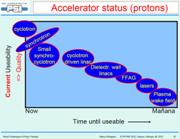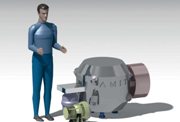![]() Diagnostics based on Higher order mode port signals
Diagnostics based on Higher order mode port signals
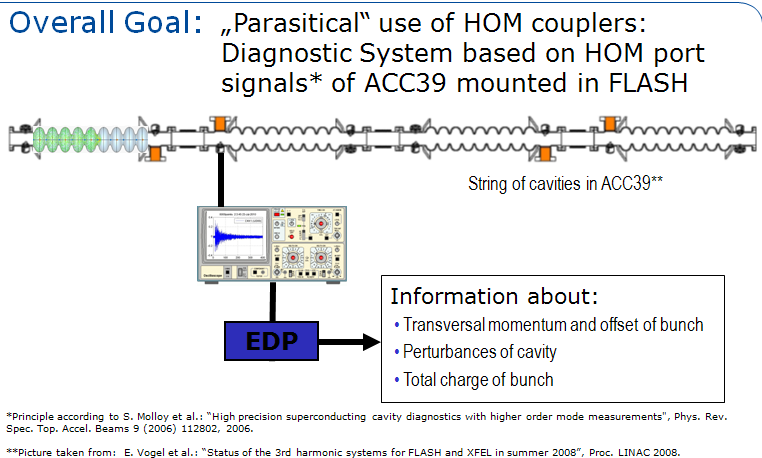
"Parasitical" use of HOM couplers. Image credit: Universitat Rostock
Higher order mode (HOM) couplers are a crucial part of many superconducting cavities since unwanted modes, which are excited by the beam, need to be damped effectively. EuCARD WP10 task 5 is predominantly dealing with studies on diagnostics based on HOM port signals. This task is carried out jointly with the teams around Roger Jones (University of Manchester, speaker) and Nicoleta Baboi (DESY).
Monitoring the HOM port signals as a by-product of the HOM damping offers the possibility to determine the transversal offset, the total charge of the bunch, etc. with little additional hardware.
One major concern of the ongoing studies is to predict the theoretical accuracy of the diagnostic system in the context of uncertainties such as perturbations of the cavity from the design shape. The entire investigation is based on three pillars: First, experiments at the FLASH facility at DESY in Hamburg are undertaken with the focus on the third harmonic module ACC39. Second, numerical simulations are performed using existing commercial programs such as CST MICROWAVE STUDIO® and in-house codes. Third, new computational methods are developed and implemented. In this context, a method to determine wake fields in large structures by means of decomposition techniques is constructed. Moreover, a generalized perturbation theory is in development which determines a set of eigenmodes of the perturbed geometry based on a set of eigenmodes of the unperturbed shape. Overall, the research efforts are aiming for a sophisticated understanding of diagnostics based on HOM port signals. The long term goal is the equipment of current and future machines with diagnostics based on HOMs.
![]() EuCARD-2 approved by the EC
EuCARD-2 approved by the EC

Image credit: EuCARD-2
The project will be led by Maurizio Vretenar of CERN, and builds on the success-to-date of the EuCARD project. The project's full title - Enhanced European Coordination for Accelerator Research & Development - reflects the extended scope to include more participants and more work packages. It brings a global view to accelerator research, coordinating a consortium of 40 accelerator laboratories, technology institutes, universities and industry to jointly address common challenges. EuCARD-2 will include six networks on strategic topics to reinforce synergies between communities active at all frontiers, extending the scope towards innovation and societal applications. The networks concentrate on extreme beam performance, novel accelerator concepts with outstanding potential, energy efficiency and accelerator applications in the fields of medicine, industry, environment and energy. The EuCARD-2 kick-off meeting will be organised with the last EuCARD annual meeting on 10-14 June 2013 at CERN.

NCLinac (WP9 of EuCARD) includes improvements to the CLIC test facility CTF3 at CERN. Image credit: CERN
Building on the success of their feasibility phase, the CLIC test facility, CTF3, has just launched into a five-year project development phase. This will involve detailed performance optimisation studies, marking the project’s transition from pure research and development to prototyping and construction.
CTF3’s second phase will focus on selected performance-related research areas for further investigation. The largest of these involves the construction and testing of several authentic CLIC accelerator modules that are currently being assembled at CERN (see image).
Four of the CLIC modules will undergo mechanical testing in laboratory conditions, where they will have their alignment, stabilization and thermal cycling tested. These tests will be done over the next 2 years outside of the CTF3 facility. The remaining three modules will be installed in CTF3’s experimental area. Two further modules will be added in 2014, and will incorporate results from both the laboratory and CTF3 tests.
Alongside the module testing, the CTF3 team will be working to provide synchronicity between CLIC’s drive beam and its main beam. This is accomplished by compensating for any phase “jitters” by adjusting the path length of the drive beam. Phase monitors and a kicker system (which will adjust the beam path) are currently being installed in the facility, and the first system tests are planned for next summer.
Article originally in CERN Bulletin.
Reproduced with permission.
![]() Circulating ideas about a new Higgs factory
Circulating ideas about a new Higgs factory

Sketch of LEP3/TLEP double ring: a first ring accelerates electrons and positrons up to operating energy 45-120 (180) GeV and injects them at a few minutes interval into the low-emittance collider ring, which includes high luminosity interaction points (A. Blondel/U. Geneva)
Could the LHC tunnel one day house a high-luminosity electron-positron collider? This idea joined others at the LEP3 Day, held at CERN on 18 June 2012.
In 2011, early LHC indications suggested that the Higgs boson might be light, with a mass in the range 115-130 GeV. On Christmas’ Eve 2011 the first concrete proposal for a high-luminosity circular electron-positron collider was presented after Alain Blondel of Geneva University realised that an object like this could be studied in the LHC tunnel at about 240-GeV centre-of-mass energy.
This, along with the numerous encouraging reactions to this proposal, led the EuCARD Work Package 4 “AccNet” to organise a “LEP3 Day”, which was only a few weeks before the LHC’s ATLAS and CMS experiments announced the discovery of a Higgs-like boson with a mass of 125 GeV. About 40 motivated accelerator physicists from Switzerland, Japan, Russia, US and the UK participated in this EuCARD LEP3 Day, including Steve Myers, CERN Director of Accelerators and Technology, the KEK trustee Yasuhiro Okada, and members of CMS and ATLAS. A full report on the LEP3 Day is now available.
![]() Achievements so far, as EuCARD enters its final year
Achievements so far, as EuCARD enters its final year
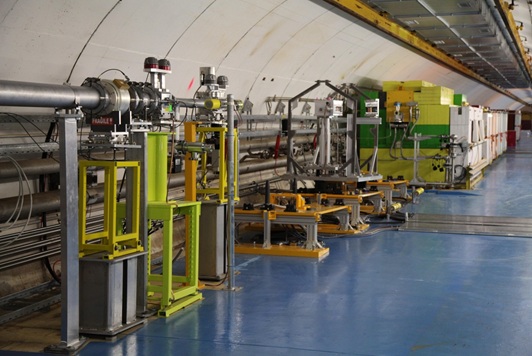
HiRadMat installation and comissioning is now complete. EuCARD Transnational Access is now taking place at this facility.
Image credit: HiRadMat, CERN
The EuCARD project has just finished a successful 2nd period of 18 months, achieving most of its objectives and technical goals, and has started its 4th and final project year with more than 130 scientific papers published.
From the networking work packages, NEu2012 initiated a range of actions all aimed at creating a common roadmap to be proposed as the European accelerator neutrino programme to the relevant decision-making bodies. AccNet organized 8 successful workshops on various topics, such as crystal collimation, electron clouds, crab cavities and beam optics control. Within AccNet, a new network has also been established to bring together scientists from the plasma wakefield acceleration community. The highlights of transnational work packages included the HiRadMat (High Irradiation to Materials) facility at CERN becoming operational and within the ICTF facility at STFC, there is an improved resolution of TOF counters, new measurement of muon beam contamination and tests of the Electron-Muon Ranger detector.
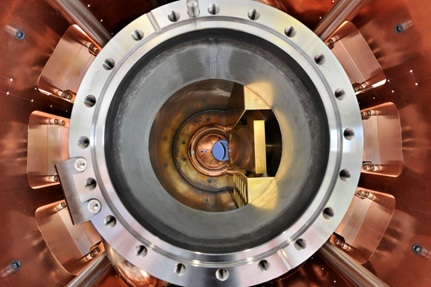
The FAIR cryo-catcher prototype seen from the back mounted in the cryostat It was tested with heavy ion beam of GSI’s SIS18.
Image credit: GSI
The achievements of Joint Research Activities included the design of a dipole insert magnet as well as novel metal-diamond composites being identified as promising materials for collimation efficiency. Mechanical stabilisation to below a nanometre has now been obtained at CLIC. Furthermore the prototype crab cavities for both LHC and CLIC have been built and the LHC cavity has been fully characterized. The EMMA FFAG and instrumentation line are also now operational. Achievements also include a successful demonstration of a new method, based on X-ray measurements, for measuring the transverse emittance in laser-plasma accelerators. The full progress report is now publicly available.
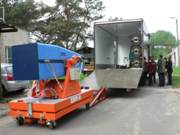
Lillyput 3 is an industrial accelerator with photon energy 6 & 9 MV that is easily transportable for nondestructive inspection tests. (click image to enlarge) Image credit: NCBJ, HITEC division
The largest research institute in Poland, the National Centre for Nuclear Research (NCBJ) showcased an impressive variety of accelerator R&D and construction during the recently held EuCARD annual meeting in Warsaw.
Created in 2011, NCBJ merged the Soltan Institute for Nuclear Studies (IPJ) and the Institute of Atomic Energy POLATOM, and now has more than 1,000 employees. The institute is involved in several international projects and research infrastructures, constructing components such as proton buncher and –mode structres (PIMS) for the LHC Linac4, higher order mode (HoM) absorbers for European-XFEL, developing e- accelerator for the GBAR experiment at CERN, integrating elements of neutral beam injection system (NBI) for the Wendesltein 7-X stellarator in Greifswald, etc.
It is home to the research reactor MARIA, specialising in neutron beam research, activation analysis and isotope production for medical use. In addition, NCBJ develops accelerators for industry, such as the non-destructive inspection techniques of Lillyput, and accelerators for medicine, such as COLINE linear accelerators used in radiotherapy for treating cancer.
|
Work presented at EuCARD’s Annual Meeting highlights important developments for the next-generation of collimators. The results not only impact the LHC’s performance, they also have the potential to go beyond pure accelerator applications. To bring the LHC beyond its nominal performance, a new generation of collimators will be needed with advanced materials. The ColMat Task 8.2, part of work package 8 of the EuCARD project, is testing a variety of composite materials for the production of prototypes. These tests include shock-wave analysis, FLUKA and LS-Dyna software simulations, irradiation studies, and mechanical tests. To be effective, collimation systems must satisfy two main functions: removing stray particles, which would induce quenches in super-conducting magnets; and shielding other machine components from beam orbit errors. Metal Matrix Composites, such as diamond or graphite reinforcements, as well as copper and diamond, and molybdenum and diamond, are being studied to assess their qualities in addressing the intrinsic limitations in current collimators. From the initial tests, Metal Matrix Composites with diamond reinforcements have shown to be particularly promising as they combine properties such as robustness and high thermal and electrical conductivity from both compounds. Not only does this benefit future collimators, but Alessandro Bertarelli highlighted in his presentation and subsequent report that this R&D programme has the potential to be useful to nuclear, aerospace and thermal management communities as well. |
![]() EuCARD highlights new developments
EuCARD highlights new developments
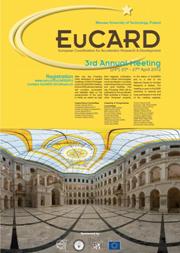
Poster for the 3rd Annual Meeting of EuCARD in Warsaw 24-27 April 2012
http://cern.ch/eucard2012. Image credit: EuCARD
From within the project or via invited speakers, highlight talks at the EuCARD annual meeting are always a rich source of information about key developments in the accelerator sector. This year's meeting in Warsaw is no exception.
From the EuCARD project itself, highlight talks include LHC compact crab cavities and beam squeezing schemes, showcased alongside CLIC precision alignment and high-field magnet developments. Topics range from plasma wakefield acceleration to collimator designs, from neutrino physics to superconducting and low-level radio frequency (LLRF) updates.
Beyond the project, participants will also hear about progress in Polish institutes NCBJ Swierk and WUT, as well as accelerator applications such as medical isotope production and accelerator-driven nuclear power. The current status of the EuCARD-2 proposal, which scored 14/15 and will shortly enter negotiations, will also be presented. With such a range of topics showcased, there is certainly something for everyone.
|
In February, the physics and medical communities came together at the ICTR-PHE 2012 conference in Geneva. Within the scientific programme, the session "Novel Technologies in Radiation Therapy" looked at the present and emerging roles of accelerators in medical treatments. The session opened with "Novel Techniques in Proton Therapy" by Marco Schippers, PSI, who explained the need for high quality, accuracy, flexibility, intensity and energy coupled with low prices and hence reduction in size. Currently the cyclotron scores the highest for usability for proton therapy, but, in the future, linacs, FFAG and plasma wakefield may also prove usable options. In addition, Dewi Lewis, in his highlight talk at the EuCARD annual meeting, presents "Evolution of accelerator design for medical isotopes production", linked to his recent article in the CERN Courier "Medical-isotope cyclotron designs go full circle", This article examines the role of cyclotrons in medicine over the years and discusses the interplay that has existed between industry and the accelerator laboratories. The article showcases the latest collaboration between CERN and CIEMAT, using LHC accelerator technology and expertise to help design and build the smallest-possible cyclotron using superconducting technology with a proton energy of around 8 MeV, the objective being to produce single-patient doses of radioisotopes. |

